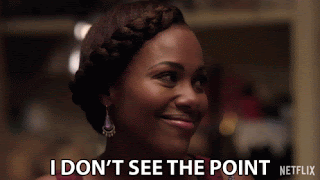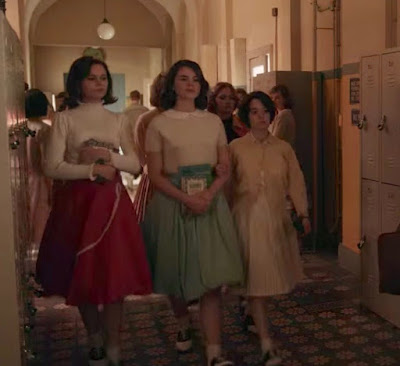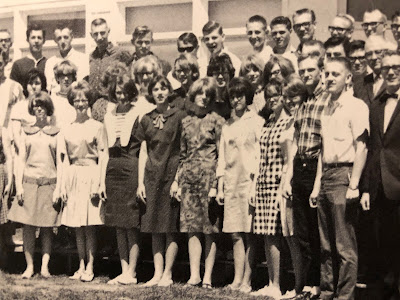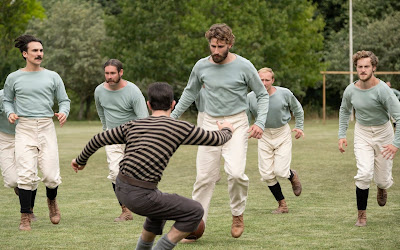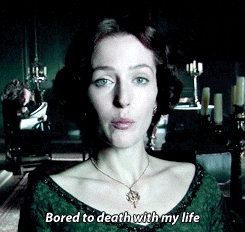Looks like I've taken a six month break from blogging, but we are still living with covid restrictions, the world is really stressful, and I'm watching period shows again. So here we are!
I recently watched The Queen's Gambit and agreed with the general consensus that it was excellent and the costumes were gorgeous. I also love a female character is was smart and also interested in clothes. Too often those are treated as mutually exclusive things. BUT there was one particular costume choice that I had a BIG problem with: LONG FULL SKIRTS IN 1966.
Beth wears this dress at two chess tournaments in 1966: Las Vegas and Mexico City. So we see a lot of it from many angles. The skirt is fluffy and full, and she wears a crinoline under it to make it even fuller.
This silhouette: a small waist with full skirt that falls well below the knee is very 1950s. It lingered in the early 1960s, but was pretty outdated by 1966. We actually see the dress at Ben Snyder when Beth first visits the store with her mother--in
1963. Several costumes from the show, including this dress are on display at the Brooklyn Museum right now.
The online exhibit dates it to 1960. So by the show's own admission, this dress is 3-6 years old.
In fashion school, I remember my professor saying "the 1960s were like 100 years," meaning that so many styles and changes in fashion were packed into a very short amount of time. So picking a 1950 dress to portray 1956 might not be so noticeable, but wearing a 1960 dress in 1966 would. It isn't just one dress though. Most of the outfits Beth wears at these two competitions have similar full, long skirts.
This last one is reallllly long.
I poked around online to see if any other fashion historians were pointing this out. I found
this video which mentions the skirts but is very forgiving. She argues 1) Beth is young and still figuring out her style. She goes through a major style transformation after these tournaments and the costume designer wanted to show a contrast. 2) She is from Kentucky and so she and her peers are a bit behind the times. Ok, so I can handle the first explanation even though I disagree that this is the right choice to portray it. But I have a BIG problem with the "people in Kentucky don't know any better" argument.
This "Kentucky is still stuck in the 1950s" idea is played out in the scenes of Beth at high school. While most of these take place in 1963, where it was more reasonable to find these full skirts lingering, her classmates wear aggressively stereotypical 1950s clothes. Like, saddle shoes and literal poodle skirts.
It should be noted that these are the popular girls. The girls who make fun of Beth for shopping in the discount section--which suggests that they are affluent enough to not buy discount and have some sense of what is "in." We would expect them to be the most fashion forward students at the school. And let's be real, Lexington is a city. Not London or Paris, sure, but not exactly rural. It is 1963 and they all look like extras in Grease.
 |
| Two women at the 1962 Worlds Fair in Seattle |
As a fashion historian out in Seattle, I've also heard some version of this from people on the other coast--this idea that the farther you get from New York the farther back in time the fashion goes. No. Let me stop you right there. This line of thinking is ridiculous and condescending and shows a gross misunderstanding of the American fashion system and ready-to-wear industry. Sure, teens in Lexington aren't likely to be on the cutting edge. A few months behind? Sure. But this is the 20th century. They have newspapers, and magazines, and TV. They have seen Jackie Kennedy in her boxy jackets and straight skirts. And if it were true that people in distant corners of America were 2-6 years behind on fashion, my mother would have been the poster child for that.

In 1966 my mother was a senior at Lustre Christian High School in rural Montana. And by rural I mean
rural. Lustre is a farming community about an hour drive outside of Glasgow Montana, which was
recently certified as the middle of nowhere. Here are some pics I found in her 1966 yearbook:
My mom is in the front row, fourth from the left. The girl second from left has a fuller skirt with a tighter waistline, but it is a pleated skirt not a circle skirt. Everyone else has very straight skirts and loose or dropped waistlines. Most of the dresses are homemade and certainly nothing "designer," but still pretty representative of the 1966 silhouette. There were some much shorter mini skirts out in the world at this time, so the just-at-the-knee length is on the conservative side--but they are all still shorter than the skirts that Beth wears!
This is the senior class (yes, the whole class) singing at graduation. All the girls are wearing matching white dresses which are straight and again, fall right at the knee. And this is a farming community HOURS drive away from anything resembling a city the size of Lexington, Kentucky.
These were the most fashion forward girls I spotted in the 1966 yearbook but my mom was quick to interject that they were stylish because they were from farther away and lived in the school dorm. Oh were they from Chicago or something? Or exchange students from London? No, they just lived "closer to Wolf Point." Um, Wolf Point is the town that came in 3rd on that list of "middle of nowhere" communities.
When I asked my mom if she thought Lustre was behind the times in terms of fashion, she sort of scoffed and said "we had the Sears catalog." Which is to say that no, they weren't reading
Vogue or up on what was going on in the streets of London or the runways of Paris. But even the most mainstream, middle American source for fashion was still readily available. The way fashion goes from
Vogue to Sears isn't about a length of time as much as a
translation of a cutting edge looks into something more affordable and sellable (or sewable). The American ready-to-wear industry was very experienced at this quick-translation game because customers all over the country wanted the "latest" styles, just in versions that they could afford or sew themselves. It turns out you can
view an entire 1966 Sears Catalog online here, so let's see what kind of fashion images were available to teens from "backwater" places like Kentucky and Montana.


Not cutting edge, but a solid representation of mid-1960s style. And WAY more fashion forward than what Beth wears to her tournaments.
Now, TO BE FAIR I was surprised to see a few fuller skirts in the Sears catalog. I spotted this green one in the image below and a few more marketed to older women. So I'm not saying that fuller skirts had completely vanished from the planet by 1966. But while the skirts were full, they were much shorter than what Beth wears. Townes acts impressed by how "grown up" Beth looks when he sees her in Las Vegas, but she would have actually looked very dowdy for the time.

Now I can accept "we took some artistic license with Beth's costumes to show a more dramatic change after her 1966 tournaments" and "we picked these longer skirts because they looked great on the actress and would appeal to the 2020 audience." Fine. Sure. But realistically, a teen girl with her own money and a budding interest in fashion would be picking more updated looks. The "well, she was from Kentucky," argument is just nonsense. If the girls at Lustre Christian High School knew about current fashion trends, the girls in Lexington certainly did too.
I'm coming for you next, Bridgerton.








